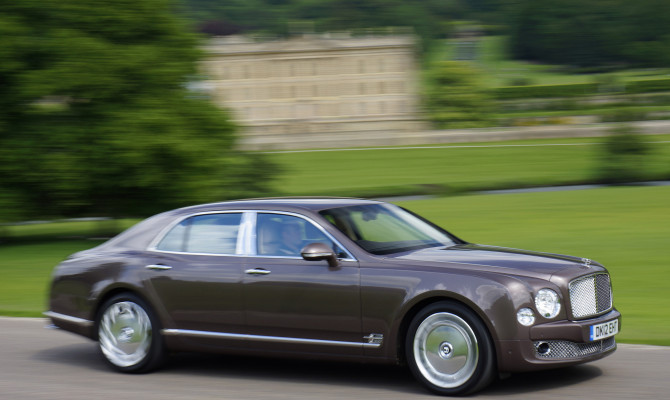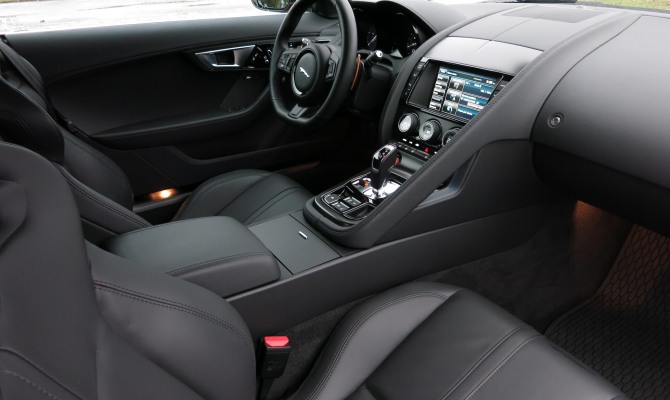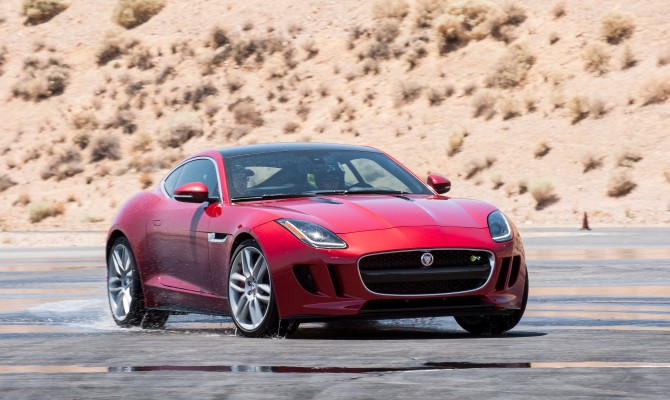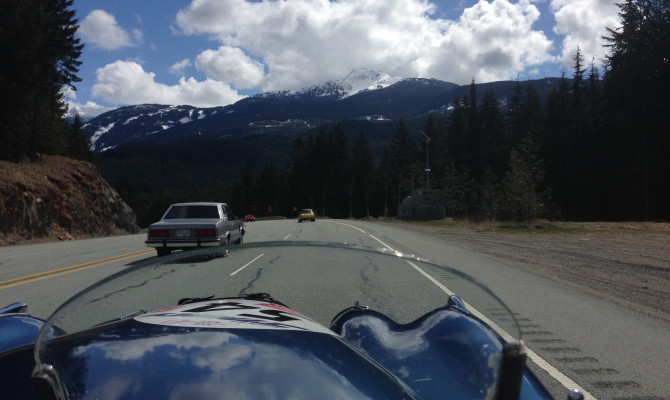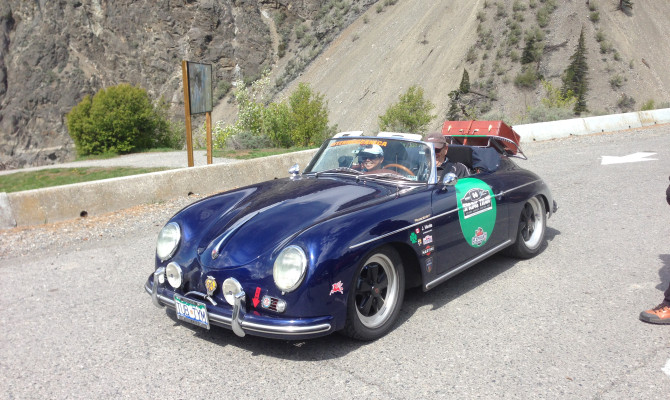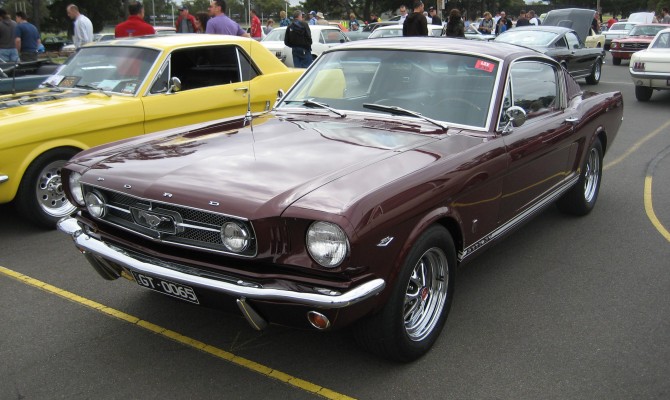Jaguar has unleashed its first electric vehicle – the Jaguar I-PACE – onto the streets of London for the first time.
Driving on the streets of London’s famous Olympic Park, the electric performance SUV concept previews the Jaguar brand’s first electric vehicle, the Jaguar I-PACE, which will be revealed in late 2017 and will be on sale in the second half of 2018.

“The feedback on the I-PACE Concept has been fantastic,” said Jaguar Director of Design, Ian Callum. “With the I-PACE Concept we’ve torn up the rule book to create a vehicle with supercar inspired aesthetics, sports car performance and SUV space, in one electric package. It has surprised people and the enthusiasm for our first electric vehicle has been beyond all my expectations.
“Driving the concept on the streets is really important for the design team. It’s very special to put the car outside and in the real-world. You can see the true value of the I-PACE’s dramatic silhouette and powerful proportions when you see it on the road, against other cars.”
The Jaguar design boss says the future of motoring has arrived in the shape of the I-PACE Concept.
Powered by a 90kWh lithium-ion battery, the I-PACE will be able to accelerate from 0-100 km/h in around 4 seconds, with a targeted range of approximately 355 kms. Charging is easy and quick; an 80 percent charge can be achieved in 90 minutes and 100 percent charge achieved in just over two hours using 50kW DC fast charging.
Compact, lightweight electric motors at the front and rear axles generate a combined output of 400HP and 516-lb ft of all-wheel drive torque, putting power down and maintaining traction on a variety of surfaces and weather conditions.
“There are cars on show for the rich and cars for the super-rich; neither status describes me but it won’t stop me looking.”
You can dream about luxury cars and even touch them at the Vancouver auto show.
2016 Cadillac CTS-V
The new CTS-V is the pinnacle of Cadillac’s renaissance, repositioning itself as a high-performance luxury brand able to compete with the likes of BMW and Audi for the well-heeled 40-something power broker. This 200 mph 4-door sedan houses a Corvette engine, but not just any Vette V8. The 2016 CTS-V is infused with the supercharged 6.2L V8 power plant engineered for the formidable 2015 Corvette Zo6. It eagerly dispenses 640 horsepower and 630 lb.-ft. of torque to the V’s rear wheels through an 8-speed automatic transmission featuring shift paddles. Pulling the CTS-V rapidly down from 200 mph is a set of Brembo cast iron disc brakes, which are more effective at shedding heat than carbon-ceramic setups. No firm price yet.
2016 Lexus RC F
The all-new track ready 2015 Lexus RC F adopts the best of the tuning and technology that went into the Lexus LFA Supercar to create an authentic high-performance coupe. Fully capable of running on a racing circuit and featuring the most powerful Lexus production engine to date – s 467 horsepower 5.0L V8. The Lexus RC F is for those ready to immerse themselves in pure driving pleasure. Available in two models starting from $81,650.
Jaguar F-TYPE Convertible
It’s hard to argue with Jaguar’s description of the F-TYPE as being pulse-quickening. It combines effortless, exhilarating performance, instant response and precise, agile handling with everyday refinement and usability.
The Jaguar supercharged 3.0 litre V6 340 hp engine delivers powerful and efficient performance. Select from a rich variety of colour combinations for body and cockpit. Acceleration is clocked at 0-100 km/h 5.3 seconds, with a top speed of 260 km/h. Priced from $76,900
Bentley Mulsanne
The Mulsanne is the flagship of this esteemed British marque.
It’s simply sumptuous inside, thanks to the use of finely handcrafted materials and painstaking attention to fit and finish. The dashboard is measured to accommodate the thickness of leather that wraps around it precisely. The infotainment screen it surrounds, meanwhile, can be concealed behind a veneered panel when not required for route navigation, rear camera view or other control functions.
The Mulsanne includes a 14-speaker sound system with Digital Signal Processing (DSP). Audio perfectionists have the option to go even further: the Naim™ for Bentley system comprises 20 speakers, 22 channels and 2200 watts of aural perfection.
Under the hood is a re-calibrated 6.7-litre V8 engine, which generates 505 horsepower and takes the luxury car to 100 km/h in a time that matches the lithe Jag F-TYPE.
Expect to pay at least $480,000.
BMW i8
The BMW i8 is a sports car with the fuel efficiency of a micro-car!
This is possible because the powerful plug-in hybrid system with the combination of BMW eDrive technology and a BMW TwinPower Turbo 1.5-litre, 3-cylinder gasoline engine brings together the benefits of an electric motor and a gasoline engine to produce an outstanding driving experience.
And its efficiency is powerfully aided by the carbon-fibre car’s sleek design. The front appears extremely low and wide and everything is arranged to be optimally aerodynamic.
There are cars on show for the rich and cars for the super-rich; neither status describes me but it won’t stop me looking.
Contact: rrothwell [at] drivewaybc [dot] ca
“It’s a watershed vehicle for the storied manufacturer, and one deserves every bit of praise it receives…”
by Rob Rothwell
As I dropped my aging butt into the heavily contoured driver’s seat of Jaguar’s new F-Type Coupe the first thing I learned was that it was a long way down!
High doorsills made ingress even more challenging but the hardship of entry was well worth its cost.
With the introduction of its F-Type, the storied British marque now offers hope to greying loyalists needing validation that sixty is the new forty. Regardless of age, the machine rewards its pilot with an exhilarating driving experience more Porsche-like in its execution than Jaguar-traditional.
The F-Type – nominally regarded as today’s version of the revered E-Type – arrived on Canadian soil as a 2014 model, available only as a convertible roadster. For the 2015 model year, Jaguar put a lid on its edgy two-seater with the introduction of the Coupe version. Its stunning lines steal the spotlight from the near-venerated convertible.
Surprisingly, the sensual body of the UK’s latest icon encompasses plenty of head and legroom, not to mention decently sized stowage beneath its narrow rear hatch. But Costco capacity isn’t a hallmark of sports cars, the F-Type included. Of greater importance is what’s beneath the bonnet.
A range of three power plants are available, two of which are supercharged V6 mills each displacing 3.0 litres yet developing 340 and 380 horsepower respectively. The subject of this week’s review is the brawnier of the pair, denoted by the “S” within the Coupe’s nomenclature.
A third engine choice ups the testosterone immensely. The supercharged 5.0 litre V8 beneath the hood of the F-Type R Coupe dispenses a massive 550 horsepower to the Jag’s rear wheels. All three engines are backed by a ZF QuickShift 8-speed automatic transmission with shift paddles.
With regret, I must inform our driving purists that the F-Type – Coupe or Convertible – is not available with a manual transmission. Pity really. Nonetheless, this cat has claws and plenty of forced-fed performance.
Unlike its more traditional siblings, the F-Type doesn’t impart the soothing qualities of a restrained engine note and supple underpinnings. Nope. Nada. Rather, it is raucous, brash, and by some accounts – that being my better half’s – uncivil. The raunchiness is justified though given the exceptional performance capabilities and egoistic essence of the machine.
Jaguar literature pins a 0-100km/h time of just 4.3 seconds on the F-Type R Coupe and 4.9 seconds on the slightly tamer S version. The base car arrives at 100km/h in 5.3 seconds, yet there’s far more to this cat’s ability than sprinting.
I particularly enjoyed my tester’s quick, precise steering and exceptional road-feel. Communicative steering allows the driver to feel every little tug and tag the road surface inflicts upon the wheels, which the F-Type delivers with little filtering. This quality also enables the driver to sense the approaching adhesion limits of the rubber, which is essential for track driving.
I had the opportunity to drive the F-Type on Mission Raceway’s road course last year and know from that experience just how competitively the car performs. There is true sports car DNA here with driving dynamics further hastened by highly responsive brakes, which clamp immediately and remain predictable, linear, and fade-free throughout.
While the F-Type may not be my choice with a free pass to the Jaguar showroom, it’s a watershed vehicle for the storied manufacturer, and one deserves every bit of praise it receives.
F-Type Coupe Specs
Base F-Type
Power: 340 horsepower – 3.0 litre V6 Supercharged engine
Performance: 0-100 km/h in 5.3 seconds
Fuel Economy: 11.8 8.4 L/100km city and highway
Starting Price: $72,900
F-Type S
Power: 380 horsepower – 3.0 litre V6 Supercharged engine
Performance: 0-100 km/h in 4.9 seconds
Fuel Economy: 12.2 8.7 L/100km city and highway
Starting Price: $84,900
F-Type R
Power: 550 horsepower – 5.0 litre V8 Supercharged engine
Performance: 0-100 km/h in 4.2 seconds
Fuel Economy: 15.0 10.2 L/100km city and highway
Starting Price: $109,900
“It’s a Las Vegas-like atmosphere, where even in the dead of night, you’d be fooled into thinking it’s daytime…”
Downtown Niagara Falls can induce sensory overload for some. Including myself.
The Ontario city’s bright lights, flickering signs and novelty-themed stores take some time to absorb into the system. It’s a Las Vegas-like atmosphere, where even in the dead of night, you’d be fooled into thinking it’s daytime. The illuminated multicolour bulbs pulse as gatherers from all over soak it all in. Then there are the casinos…
One could also experience a sensory overload when a Jaguar F-Type R Coupe growls with purpose as it saunters down the road.
Inside the cabin, you’re greeted with everything that might make your senses tingle. A carefully crafted cabin, an 8-speed automatic transmission and 550 prancing ponies from a 5.0L, V8 engine, wait patiently to be unleashed on a purpose-built handling course.
Not to mention, there’s also a Porsche 911 Turbo S, a BMW M4 and Chevrolet Corvette Stingray Convertible all eager to accompany you on a test loop.
Those four vehicles comprise the Prestige – Performance (over $75K) category at the Automobile Journalists Association of Canada’s annual TestFest; a time when journalists from all across Canada have the opportunity to back-to-back test what’s new on the market (See Bob McHugh’s TestFest Driveway cover story). Before my senses went into overdrive (with the Jaguar and others), I had a much more sensible time with my specifically assigned categories.
The first of three groups I tested was the Small Car under $21k, which included the Honda Fit and the Nissan Micra. Then there was the SUV/CUV under $35k class including the Honda CR-V, Nissan Rogue and the Subaru Outback 2.5i. And finally, Sports/Performance under $50k that allowed me to get behind the wheel of the BMW M235i, Ford Mustang (with the 2.3L, 4-cylinder Ecoboost engine), the Kia Forte Koup, Subaru WRX STI and the VW GTI.
The Nissan Micra, for just under $16k is a great value and the car is fun to drive.
Then there’s the Subaru Outback ($33,695- price as tested), which was a surprise for me. It didn’t break a sweat on the off-road portion of the test and drove really nicely on the road. Of course, I can’t complain when I have the keys to the seventh generation VW GTI, or the Subaru WRX STI, or even the BMW M235i.
Yes, it’s fun to enjoy the combined effort of engineering, design, and execution prowess, but the modus operandi of the weeklong event is to pick the best of the best.
While it’s fantastic to take out some of the most incredible machines on the market, I was pleasantly surprised how much I took to the City Car category. Driving the Kia Soul EV and the smart fortwo electric drive were definite highlights.
Being a huge fan of EVs, it’s nice to know that the category is growing. I mean, I’d love to be able to afford a Tesla Model S (as would many), it’s just not always a reality. But the pint-sized smart and the roomier Soul EV are ideal urban rompers.
Another noteworthy vehicle that impressed me was the Volvo V60 Polestar. Clad in a Rebel Blue exterior colour, it was a hoot experience. With 345 horsepower from a turbocharged 6-cylinder engine, the all-wheel drive wagon is not only practical, but also something that left me wanting to drive it again and again. There’s room for five and a couple strollers in the trunk. A perfect family hatch?!
Then there was the Challenger Hellcat. I mean, 707 horsepower in an urban setting seems like overkill, no? Nevertheless, Dodge has done a fabulous job with updating the interior and overall refinement of the vehicle that now turns even more heads.
Winners will be announced here starting in December.
Contact: alexandra [dot] straub [at] drivewaybc [dot] ca
This Jaguar is a car that demands attention when you look at it and gets respect when you drive it…
If there is such a thing as an affordable supercar, the 2015 Jaguar F-Type Coupe might just come close.
Of course, that is relatively speaking, when compared with the sticker prices of its rivals.
This Jag will turn heads, thanks to its styling, and wealthier shoppers will doubtless be interested due to the price. Just as last year’s F-Type convertible won the praises of auto journalists and the buying public, the hardtop version of this sexy car is more engaging, more powerful and arguably more beautiful. The North American launch for the Coupe was held in California traversing the twisty roads outside Los Angeles on the way to the Willow Springs racetrack for a thunderous romp around the circuit as fast as my skill would let me.
Looks
The F-Type is sold with three trim levels, the $72,900 base, then the $84,900 S and the top of range R for $109,900. With 340hp, 380hp and a whopping 550hp, respectively, these cars are up on power and down on price when compared to similar priced/horsepower Porsches. (The one exception is the new 450hp Corvette Stingray that has 450hp and a stunning $55,000 starting price.) What this car has over the competition, and the convertible version, is a sleek body and platform formed entirely from aluminum. With a special hydro-formed roof support that can carry four times the vehicle’s weight, the stiffness of the coupe is eighty percent greater than the convertible. And a stuff structure is what is needed if you want to make a supercar. The convertible has a 495hp but the coupe is fitted with a 550hp version of the supercharged V8 because the body and chassis has the strength to accommodate such a powerful engine.
Inside
Almost every review of the convertible commented on the raspy exhaust note from either the supercharged 3.0L V6 or V8 engines. The S and R models of the coupe also get a sports exhaust that can be made louder or quieter with the press of a button, but the fixed roof of the coupe muted the impact compared to the convertible.
On the road to the track event, I drove the supercharged 380hp S model fitted with superb sports seats and leather everywhere that matters, like the doors and dash. The back cargo area is surprisingly big and capable of accommodating two sets of golf clubs. Jaguar has done a superb job of finishing the hatch area with a cover that helps separate the cabin from the trunk area.
The three main dials on the centre console are easy to use for heat and air conditioning but the radio/navigation unit is not as quick or precise as I would like. In fact, I missed three turns on our drive route due to the lag in navigation display.
Drive
As the trim levels increase in price the added features are not so much about additional luxury items, rather more performance features. As each trim gets more power, there are more aids to help get all that power down to the ground. The S trim gets performance brakes and a mechanical limited slip differential but the R model adds torque vectoring to help steer the car through the corners and an electronic active differential to apply power more precisely to the rear wheels when the driver asks. Ceramic brakes are also an option on the R trim. My instructor at Willow Springs was Davey Jones, who has two Rolex Daytona watches to show for his wins at the 24-hours of Daytona. The R on the track is nothing short of amazing.
With such low-end grunt from the supercharged 5.0L V8 engine and endless horsepower, the all-aluminum F-Type just danced in every situation. Willow Springs is a technical track but after a half dozen laps, the powerful cat roared with pleasure in every turn. In performance mode the electronic aids are more forgiving allowing the car to rotate in the corners when pushed hard, the steering is very sharp and the driver can actually get the power down with confidence.
Verdict
The Jaguar F-Type Coupe is an expensive machine but in the supercar world is a relative bargain. If you are in the market for a Porsche or other high-end coupe, this Jaguar, especially the R version is a car that demands attention when you look at it and gets respect when you drive it.
Contact: zack [dot] spencer [at] drivewaybc [dot] ca
**********
The Lowdown
Power: 340hp, 380hp or 550hp
Fill-up: 10.4L/7.1L/100km (city/highway base)
Sticker price: $72,900-$109,900
The miracle of depreciation has put a tempting array of classic exotics within reach for many of us.
Be warned, though, that very often, the cheque you write for the purchase is just the first of many that you’ll write if you make a poor or unlucky choice. Keep in mind this maxim: The cheapest examples almost always wind up being the most expensive in the long run. Here are four that famously can be punishing on the wallet:
1966-80 Rolls-Royce Silver Shadow
At around the cost of a loaded Ford Focus for a nice one, it’s hard not to be tempted by the upper crust looks of a vintage Rolls-Royce. But go in with your eyes open: A simple brake service can exceed $1,000, with the special Rolls-Royce brake fluid going for $125 all by itself. Try to substitute something from your local auto parts store and you could be looking at $3,000 or more to repair the damage. That famous Parthenon-like grille in front is about $2,500 used if you can find one. The hood ornament alone can cost more than $1,500 should anyone decide to make a souvenir out of yours. Ouch.
1975-85 Ferrari 308 GTB/GTS
At around $30,000, this lovely thing represents one of the lowest points of entry to the storied Ferrari brand. Fortunately, Tom Selleck in the part of Thomas Magnum probably never had to foot the shop bill to maintain his employer’s 308. If he did, he’d likely have had to pawn the Hawaiian shirt and moustache. While Ferrari 308s have gained a reputation for being reasonably reliable cars as Italian exotics go, they are maintenance-intensive and things do break, particularly with the oldest now approaching 40 years old. That lovely combination switch that operates the turn signals and pop-up headlights? They can cost close to a grand (and they do fail from time-to-time). A belt service including the all-important timing belt needs to happen at least every five years or 30,000 miles. Ignore it and you could be on the line for a $15,000-plus engine rebuild.
1968-72 Mercedes-Benz 300SEL 6.3
The 6.3 is the closest that Mercedes ever came to building a Detroit-style muscle car back in the day (albeit a four-door one). Sporting a huge 384 cubic-inch V-8 with fuel injection and over 300 hp, the 6.3 was capable of a sub-six second 0-60 run and a 14.2-second ¼-mile time. All of this came at a huge price, though, both in acquisition costs and maintenance.
A complete rebuild of the air suspension system can cost more than $5,000, as can the wonderfully complex pre-computer, mechanical fuel-injection system. At least the parts are available.
1961-74 Jaguar E-Type
The E-Type is actually nowhere near as chronically troublesome as its reputation would suggest. This gorgeous car still seems to take a punch on a regular basis (most recently in a plot arc of AMC’s “Mad Men,” where a suicide attempt was botched because the car wouldn’t start). It is, however, a fairly complex car that takes kindly neither to abuse nor fools with tools. Burn out the clutch in your E-Type and you may wish you hadn’t been born. The list of things that have to come off of or out of the car to do the job is long. The entire massive clam shell hood, headlight and front fender assembly known by the British term “bonnet” is just the tip of the iceberg. It has to come off simply to get at the engine and transmission, which also need to part company with the rest of the car — along with three grand or so of your kid’s college fund.
**********
Rob Sass is the vice-president of content for Hagerty Insurance. Hagerty is the world’s leading specialist provider of classic car and boat insurance. Learn more at hagerty.ca and you can email rsass [at] hagerty [dot] com
Only mad dogs and Englishmen drive open top cars in the extremely chilly B.C. high country at this time of year. (more…)
Certain cars just won’t recede into the automotive fossil record.
Designers (particularly those from their company of origin) keep going back to the well. And why not?
It’s almost impossible to top the cars on this list…
The gorgeous Toyota 2000 GT sports car was a giant commercial flop when it was introduced. The status of Japanese cars in the U.S. market at the time was roughly the equivalent of Korean cars about 15 years ago, and a Japanese car that cost more than a Jaguar E-Type, a Corvette or a Porsche 911 found few takers. Just over 300 were built and the model’s failure continues to haunt Toyota. The roofline and greenhouse of the 1967 2000GT show up almost unaltered in the latest Toyota sports car concept, the FT-1. Incidentally, Toyota has probably had the last laugh here, as the 2000 GT is now the only Japanese collectible car worth $1 million.
1967 Cadillac Eldorado: The ’67 Eldorado is one of the great overlooked post-war American classics. A Bill Mitchell design triumph, it’s an ageless design that wouldn’t look out of place in a showroom today, particularly since Cadillac continues to revisit the ’67 Eldo rear end, one of the greatest ¾-views of all time.
1954 Jeep CJ-5: The original Jeep CJ may well be the most knocked-off vehicle of all time, inspiring the likes of the Toyota FJ40 Land Cruiser, Nissan Patrol, Suzuki Samurai, etc., not to mention, of course, the current Jeep Wrangler.
Jaguar E-Type: The E-Type was one of the prime influences for the above-mentioned Toyota as well as the famous Datsun 240Z. Its extreme long hood, short rear deck design and covered headlight styling cues also continue to show up in Jaguar’s own products like the XK8 and the new F-Type. After all, it was by rival Enzo Ferrari’s own admission the most beautiful car in the world.
1965 Ford Mustang Fastback: Long before Ford went retro with the 2005 Mustang, they knocked off their own design for the original pony car with the European Ford Capri. Toyota went one step further with the 1973 Celica Liftback, a virtual ¾-scale replica of the Mustang Fastback. Even the upper crust Aston Martin with its V8 Vantage model of the 1970s went to the Mustang well. The 2015 Mustang still sports design cues from the original 1965 Mustang fastback.
Rob Sass is the vice-president of content for Hagerty Insurance. Hagerty is the world’s leading specialist provider of classic car and boat insurance. Learn more at hagerty.ca and you can email rsass [at] hagerty [dot] com
The Pebble Beach auctions are generally not the place for bargain hunters.
It’s nothing unusual for $300 million in automotive merchandise to change hands with some lots bringing more than $10 million and a staggering 100-plus cars capable of cracking the $1 million mark.
Just 20 or 30 years ago, many of these cars were attainable to people of ordinary means. So what’s an ordinary mortal whose been priced out of the Ferrari and Cobra market to do? Look at some alternatives that provide 90 percent of the bang for 5 percent of the buck. Here are some of our favorites:
1963 Shelby Cobra/1992 Dodge Viper
Everybody loves a Cobra. Carroll Shelby’s idea of stuffing an American V-8 in a lightweight British sports car was an instant hit. The trouble is, if you didn’t buy one in the early 1980s when they were about $30,000, your chances of acquiring one are pretty slim for much less than a million. So, instead of a Cobra replica you’ll always have to make excuses for, why not buy its spiritual successor, the Dodge Viper? Early examples of this V-10 powered, raw and uncompromising, car can still be had for less than what Cobras were selling for 30 years ago.
1967 Ferrari 275 GTS/4 N.A.R.T. Spider/Intermeccanica Italia
One example recently sold for around $17 million. But unknown to most people, it has an American-powered near doppelganger that costs a fraction of the price.
Back in the 1960s, Canadian Frank Reisner dreamed of building Ferrari-like GT cars with American V-8 power. His Intermeccanica Italia roadster hit the mark in terms of Ferrari-like style — the bodies were even built in Italy — but in place of a complex and expensive V-12, most had small-block Ford V-8 power, with some tuned by the famous American race shop Holman and Moody.
About 400 Italias were built, and they’re not cheap (RM Auctions sold one in 2007 for $44,000). They cost a fraction of the Ferrari but have most of the looks and performance, if not the pedigree.
1965 Jaguar XKE coupe/1973 Triumph GT6
The Jaguar XKE is generally accepted as one of the prettiest cars of all time. And its great looks don’t come cheap. The first and most desirable series of the beloved XKE or E-Type now regularly brings more than $100,000. But few people know that fellow British sports car company Triumph made a three-quarter scale near replica of the E-Type, the Triumph GT6 that was also powered by a smooth and throaty straight six (albeit one that was half the size). About 10 grand buys a Triumph GT6 that many will mistake for a Jag.
Rob Sass is the vice-president of content for Hagerty Insurance. Hagerty is the world’s leading specialist provider of classic car and boat insurance. Learn more at hagerty.ca and you can email rsass [at] hagerty [dot] com
Most of the time, the automotive world doesn’t serve up a Godfather II, the rare sequel that is the equal or better of the original.
(Sometimes, of course, you get Godfather III.)
Here are the Top 5 cars that today are regarded as classics in their own right, but initially had a hard time living up to the legacy of their predecessors:
1. 1958 Thunderbird
The original two-seater 1955-57 Thunderbirds – or “Baby Birds” – were recognized as classics almost as soon as they went out of production. They were replaced by a larger four-seater that came to be known as “The Square Bird.” While the Square Bird was an immensely popular car that handily outsold its predecessor, the original two-seater remains the one that most people think of when the topic of T-Birds comes up.
2. 1979 Datsun 280ZX
The 280ZX had the misfortune of following one of the all-time greatest classic sports cars, the Datsun 240/260/280Z. And it also committed the cardinal sin in the eyes of sports car enthusiasts (although not necessarily in the eyes of the buying public) of being heavier and more luxurious.
It was derided by the magazines of the time as being a flashy “discomobile” and collectors are only now starting to realize the merits of the comfy and more grownup ZX.
3. 1971 Oldsmobile Toronado
The first generation Toronado that appeared in 1966 was a stylistic and engineering tour de force. Reminiscent of the great classic Cord 810 of 1936, it was a milestone car for GM. Hardly anyone remembers its successor, the second generation Toronado.
Where the ’66 broke the mold, the ’71 was the mold for generic American luxury cars of the 1970s.
4. 1976 Jaguar XJS
This one had the extreme misfortune of replacing one of the most beautiful cars of all time, the Jaguar E-Type. So naturally, people were predisposed to hate it when it came out. Other than initial quality control issues, which have become legendary, the XJS was neither a bad nor ugly car — quite the contrary.
But for Jaguar, lightning just couldn’t strike twice: There was simply no way that the XJS could be as lovely as the E-Type.
5. 1974 Ford Mustang II
The early 1970s were dark times for the automobile. The Arab Oil Embargo of 1973 put the brakes on large displacement high performance engines. What was Ford to do about cars like the Mustang, whose reputation was built on V-8 performance? Replace it with a four-cylinder version based on the Pinto, of course. Although V-6s and V-8s were offered, it was the sting of the anemic four-banger that stuck with the II until Ford replaced it in 1979 with what would become the very good and very popular Fox body Mustang.
Recent Comments
- { Enjoyed your Forest of Bowland in the BMW X5M, particularly the photo of the BMW in front of the main part of Stonyhurst College where... }
- { Bantam designed the Jeep, not Willy's or Ford. The American military gave the original Bantam prototype to Willys and Ford to copy. There is plenty... }
- { All Escalades come with a 6.2-lilter V8 engine that produces 420 horsepower. A six-speed automatic is the only transmission offered and drives the rear wheels.... }
- { Alexandra is an excellent journalist. }
Popular Posts
- Journey to a ‘Sparkling’ Luxury Okanagan Resort “Four lucky readers will put a Dodge Journey’s weekend-...
- The Need For Speed: Hike Those Highway Limits More than half of those polled believe the province sho...
- Drives-U-Crazy… Erratic drivers. An early morning drive from Kelowna to Vancouver is nor...
- Readers Respond: The Pros and Cons of Increasing B.C. Speed Limits Increasing the speed limits will only increase risk to...
- Honda CR-V Review: The Compact Crossover To Get Things Done The CRV is a very stylish and aerodynamic crossover veh...



